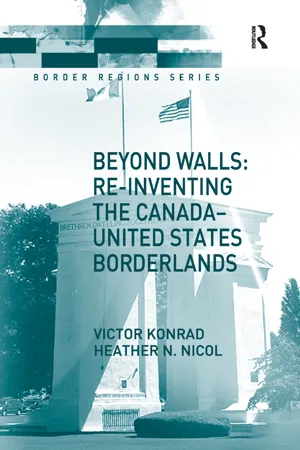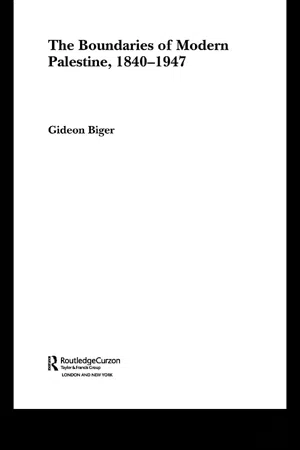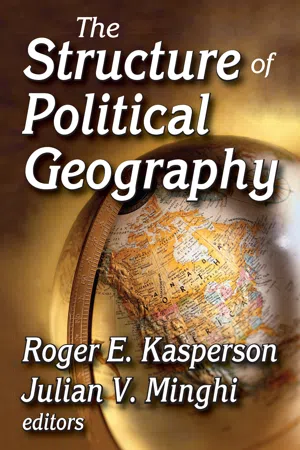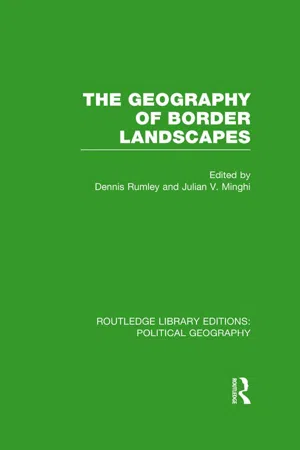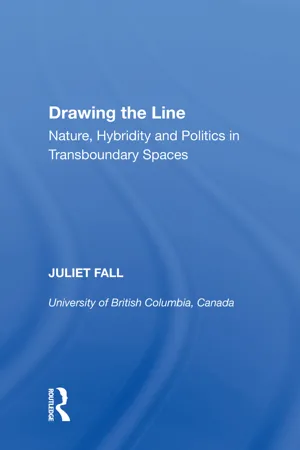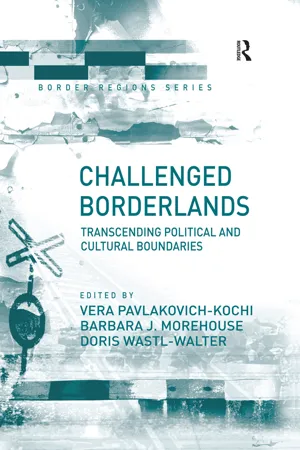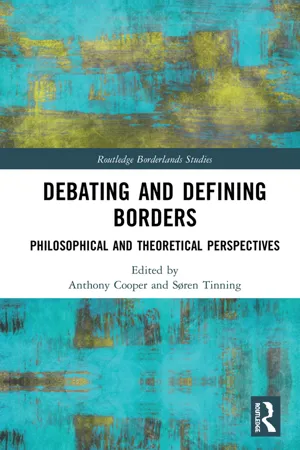Geography
Types of Borders
Borders can be categorized into several types, including natural, artificial, geometric, and cultural borders. Natural borders are formed by physical features such as rivers and mountains, while artificial borders are established by humans through treaties or agreements. Geometric borders are straight lines, often based on latitude or longitude, and cultural borders are defined by differences in language, religion, or ethnicity.
Written by Perlego with AI-assistance
10 Key excerpts on "Types of Borders"
Learn about this page
Index pages curate the most relevant extracts from our library of academic textbooks. They’ve been created using an in-house natural language model (NLM), each adding context and meaning to key research topics.
- Victor Konrad, Heather Nicol(Authors)
- 2016(Publication Date)
- Routledge(Publisher)
This is because borders “define geographic boundaries of political entities or legal jurisdictions, such as governments, states or sub-national administrative divisions. They may foster the setting up of buffer zones. Borders are complexly understood as a site at and through which socio-spatial differences are communicated.” 11 In the past, before boundaries were measured accurately and marked on the land as well as on maps, countries and less well defined political and cultural entities recognized and usually respected neutral zones or “marchlands” between them. These existed in continental Europe, Asia, Africa—all of the known world—, and anthropologists will attest, in the unknown world as well. Throughout most of the world today these zones no longer exist. Even in the deserts of the Arabian Peninsula and the Sahara, the north and south pole regions, the impenetrable Amazon basin, and other remote areas, lines were drawn in the 20th century to establish jurisdictions. Each year the number of international borderlines increases, rather than decreases. 12 In the modern world clearly defined and demarcated borders replaced the marchlands of the past. In the post-modern world, however, boundaries have been transcended in many ways, and new zones, reminiscent of the marchlands in their transitional capacity, but more complex and integrative in their nature, have emerged to expand and extend border definition in a globalizing world. Border classifications and typologies are useful for understanding how boundaries are configured and how they have emerged on the land. It is instructive to know the terms and labels for these edge concepts in order to place them in the context of the more important human processes that engage the borders of our world as limits of cultural politics. Numerous classifications and typologies were originated by geographers during the late 19th century and throughout the 20th century, and many of these were limited even in their time- eBook - ePub
- Gideon Biger(Author)
- 2004(Publication Date)
- Routledge(Publisher)
Statesmen know that boundaries are a sensitive issue in international relations, and that a threat to these boundaries can lead to major political actions. To the lawyers, the border marks the contact surface between separate sovereignties and between different law systems. The surveyors are familiar with the activities concerning the marking of a line in the landscape, and are interested in reducing the difficulties of finding the accurate line and maintaining it. A non-accurate marking can cause local conflicts concerned with ownership of agricultural land, natural resources and the like, and these can develop into international confrontations. To the militia, the border is the initial area in need of defence, and the placefrom which every offence starts, which is why the border is a target of military action in itself. These practical people see the boundary as a subject for routine occupation. On the contrary, historians, geographers and political scientists, see the boundary as an academic issue rather than a practical one.2 The political scientist sees the boundary as the defined limit of the state, and is interested in the criteria for its formation. Historians deal with the boundary’s role in causing confrontations, and permitting contact and processes to occur, alongside with its appearance as resulting from their outcome. The historian deals with the development of the boundary, and the political scientist with its nature.Geographers are interested in boundaries for two reasons, whether they are dealing with the process of its development as historians, or dealing with its nature as a political scientist. The positioning and the nature of every borderline result from mutual relations between many factors, which are partially geographic. Nevertheless – after a border has been set, it influences the surrounding landscape and the development of the separated states. These two subjects are the scope of geographical research.3Boundary classification
Geographic research on the subject of boundaries focuses on the shape and functioning of borderlines, and on the process of their development. Classification of boundaries according to their shape and nature was done according to how their location relates to physical or cultural phenomena on the surface. The most familiar classification is the division of boundaries into ‘natural’ and ‘artificial’ ones. British statesman Lord Curzon presented this classification in 1907. His classifying principles4 - eBook - ePub
- Julian Minghi(Author)
- 2017(Publication Date)
- Routledge(Publisher)
38 This general interest in boundaries as regional divides has provided concepts often applicable to political geography, as we shall see below.The utility of boundaries in studying problems of political integration and disintegration and of transfer of sovereignty will be discussed in the following Part (Process).Some Misleading Notions
The “natural-is-good” and “artificial-is-bad” concepts are based on the assumption that the degree to which a political boundary conforms to a natural feature is the measure of its success as a political divide. In other words, boundaries “established in an unrealistic manner tend to create problems commensurate to the degree with which they defy the forces of nature.” 39 Although many political boundaries are based on physical landscape features, they are all by definition political and therefore, whether naturally based or not, are man-made, hence artificial. It follows that a boundary’s “goodness” or degree of success is more a function of its role as perceived by members of the political systems it divides rather than of the environmental character of the line itself.Another widely held notion, somewhat associated with the above idea, still enjoys currency and even official authenticity. This holds that boundaries are the “enemies” of geography because they “conflict” with the operation of “geographical principles,” and hence social patterns are “compartmentalized” by these “unnatural” restrictions.40 The notion that “it is unfortunate when society must accommodate itself to boundaries rather than boundaries to society” is a logical corollary to this line of thought.41 - Doris Wastl-Walter, Doris Wastl-Walter(Authors)
- 2016(Publication Date)
- Routledge(Publisher)
All borders are initially constructed as a means through which groups – be they states, religions or social classes – can be ordered, hierarchized, managed and controlled by power elites. It is the latter who determine the demarcation and delimitation criteria for the construction and the perpetuation of the border as an institution which is strongly linked in with the agencies of power. There will always be groups and individuals who desire to cross the border, either as a means of escaping the category (social or spatial) in which he/she are located, and/or because he/she believes that the grass is always greener on the other side of the border. Transition zones, frontiers and borderland spaces exist in close proximity to all types of border, in some cases creating a trans-boundary zone of meeting, interaction and hybridity in and around open and porous borders, while in other cases emphasizing the differences which exist on either side of sealed or closed borders. This ties in with the fact that most borders, by their very definition, create binary distinctions between the here and there, the us and them, the included and the excluded. In this sense, there are common themes which are relevant to all types of border, even if this does not constitute a single model or theory in its own right. Social scientists have much to contribute to our understanding of these border dynamics, taking them beyond the limited understandings which are limited to a single academic discipline, by virtue of their inability, or lack of willingness, to cross their own professional borders which separate one discipline form the other. An important step in this respect is the creation of a common language, or glossary of terms, which are recognizable by border scholars, regardless of their specific compartmentalized discipline- eBook - ePub
- Dennis Rumley, Julian V. Minghi(Authors)
- 2014(Publication Date)
- Routledge(Publisher)
The primary purpose of the present volume is to initiate a proper debate over the nature of the border landscape concept and how it might be used. It is therefore to be regarded as a first step towards conceptual clarification and definition and, to that end, represents the views and perspectives of a wide range of geographical and non-geographical traditions. The editors wish to argue that only by ‘opening up’ the concept in this way can it be effectively liberated from the conceptual closet to which it has been confined, and hence be put to some creative use by helping us to understand better the political organisation of space.PAST CONCEPTUAL SCOPEPolitical boundaries have long been of interest as objects of study to political geographers (for example, Ratzel, 1897: chapters 17–19; Minghi, 1963). Furthermore, this line of research has traditionally tended to be more concerned with the international scale than any other (for example, Prescott, 1987).The reasons for this are not hard to find. In particular, international political boundaries provide the most obvious manifestation of the linkage between geography and politics since they are palpable spatial manifestations of political control displayed in some way in the landscape and also, of course, on maps (although interpretations of precise boundary locations might differ between contiguous states). In addition, as a de jure expression of the spatial ‘limits’ of state power, the location of international political boundaries has been subject to changes in that power with resultant conflict between and within states. The study of the evolution of primarily land-based international political boundaries has thus tended to preoccupy political-geographical inquiry in this area (Prescott, 1965).The specific definition of border areas as opposed to boundaries as the objects of analysis remains unclear in much of the literature, although the focus on disputed areas in conjunction with national boundaries provides concrete examples of an areal or regional milieu as opposed to a linear one (Minghi, 1963: 414–16). In similar manner, studies that are organised around the phenomenon of a change in boundary location tend to take a before-and-after approach in examining the impact of the change on the area actually undergoing the change of sovereignty as well as on the adjoining areas immediately adjacent to the relict and the new boundary, thereby defining a differentiated borderland (Minghi, 1963: 416–19). - eBook - ePub
Drawing the Line
Nature, Hybridity and Politics in Transboundary Spaces
- Juliet Fall(Author)
- 2017(Publication Date)
- Routledge(Publisher)
In this chapter, I outline why boundaries must be understood as complex spatial and social phenomena that construct and structure space and to what extent their definition (where they are drawn) is linked up with the idea of creating ‘ideal’ spatial entities. A boundary is the generic term for a linear spatial discontinuity that structures a given portion of two-dimensional space by dividing it into two. More simply, a boundary ‘demarcates two entities, or two parts of the same entity, which are then said to be in contact with each other’ (Smith 2000: 7). I examine the variety of arguments that have been used to define boundaries, noting the difference between biophysical and societal arguments which represent an ontological split between realist and anti-realist conceptions of space. The recurring positivist temptation of finding ‘natural’ or ‘rational’ political boundaries is explored. The tensions in the way boundaries are defined is then examined in the wider context of the construction of space and of the need to identify and define spatial entities. In the second part of the chapter, I look at the role boundaries play in defining spatial entities, dwelling on the different discourses – and spatial ideals – that underpin how space has been constructed. This sets the scene for understanding how certain spatial discourses have been instrumentalised within protected area design, both implicitly and explicitly.The nature of boundaries
Boundary, n. In political geography, an imaginary line between two nations, separating the imaginary rights of one from the imaginary rights of the other(Bierce 1911 ).At different times and places, the term boundary has meant many things to different people. Ambrose Bierce, in his famous Devil’s Dictionary , suggests a wonderfully cynical definition. In a curious twist, but without missing the joke, I take his definition seriously in exploring how imaginary lines actually come into being. While I discuss the concept from a geographical perspective, this is not the only field through which it has been studied. Approaches to boundaries can be roughly divided into two broad fields: those derived from a social science perspective, considering boundaries as predominantly social phenomenon linked to the anthropic construction of space and those derived from ecological and biogeographic traditions, defining boundaries as physical limits inscribed in the landscape at various scales. This is of course a huge simplification, but it remains a coherent and useful one, a least as a starting point.Lines, boundaries and frontiersBoundaries, borders, frontiers and limits all indicate both a line and the idea of separation into two units. The emergence of the concept has been traced back to the Roman limes imperii which separated the civilised world from the ‘barbarians’ living beyond the fines of the Empire. The limes was thus a fortified line, rather than a political boundary, while the fines - eBook - ePub
- William Outhwaite, Stephen Turner(Authors)
- 2017(Publication Date)
- SAGE Publications Ltd(Publisher)
18 The Political Sociology and Political Geography of BordersAlexander C. DienerJoshua HagenIntroduction
If political sociology can be broadly defined as the study of the relationships between the state, society, and people, then borders provide key points of intersection and interaction for studying those relations. As such, borders are intimately involved with and lie at the heart of a whole host of contemporary issues, ranging from national security and economic development to migration and cultural identity. It is hardly surprising, then, that a growing body of scholars, including economists, geographers, historians, lawyers, political scientists, and of course sociologists, have made borders the focal points of their research (see Wastl-Walter, 2011; Wilson & Donnan, 2012). Collectively, this body of scholarship constitutes a broad, interdisciplinary field of border studies replete with its own research centers, academic journals, conferences, and professional associations.What exactly are borders? As noted above, borders are normally defined as the lines of demarcation between different states, and by extension distinct economies, societies, and identities. Most people envision the political map of the world as a colorful collage of states, each possessing its own territory bounded by clear and unambiguous lines. In short, borders define the basic building blocks of the modern international system. These same basic assumptions carry over when we think of borders at smaller scales neatly partitioning space between provinces, municipalities, or even private properties. Reality is much more complicated, but that basic assumption provides a convenient starting point for our discussion.What do borders do? The question seems odd at first, since historic perceptions of borders as static dividers of space clash with contemporary notions of borders as possessing agency. Although highly varied and contingent, borders both divide and often simultaneously unite. The contradictory nature of borders is almost inherent, in that defining an inside implicitly suggests the existence of an outside and vice versa. In that sense, borders are emblematic of the dichotomy and interrelation between senses of belonging and alienation and processes of inclusion and exclusion. We tend to focus on borders as sources of conflict, but we can also point to borders as mechanisms for cooperation. This basic binary juxtaposition can be extended downward to more local spaces and everyday life. Again, reality is more complicated; for example, being inside a particular border does not necessarily mean that one feels or is regarded by others as an insider. - eBook - ePub
EU-Russian Border Security
Challenges, (Mis)Perceptions and Responses
- Serghei Golunov(Author)
- 2012(Publication Date)
- Routledge(Publisher)
1 and well-developed theories. According to Prescott, such research was more successful in establishing procedures for studying borders than for elaborating theoretical approaches (Prescott 1987: 8).Conceptual research in the field of border studies traces its roots to the late nineteenth and early twentieth centuries. Within this research, borders have for a long time been considered primarily as defensive lines against military attacks by external enemies, and to a lesser extent as regulators of the cross-border movement of people and goods. It was only after WWII that the focus gradually shifted to such issues as the regulation of cross-border flows, and the importance of border areas as zones having specific political, economic, cultural, and other characteristics.At the early stage of the discipline’s development, priority was given to the geo-political role of borders in terms of the suitability of the boundary location in terms of the interests of adjacent states (or, at least, of more powerful ones), for the purposes of defence or, conversely, the development of stable, friendly relations with a neighbouring country. In this light, attention was also paid to the conceptualization of resolving territorial disputes and establishing an ‘optimal’ separation line between their parties, the restoration of ‘historical justice’, and so on.Theoretical debates within this line of research focused mainly on the so-called>‘natural boundaries theory’, according to which the most efficient borderlines were those that coincided with natural barriers. Typically, proponents of ‘natural boundaries’ justified their expediency by the need to protect the state from potential military interventions, even if such a danger existed only in theory. Advocates of this approach differed in opinion on what the criteria for the borderline drawing should be considered the best: mountain ridges, deserts (Curzon 1907; Holdich 1916: 149–56), rivers (Lyde 1915), and the limits of ethnic groups’ settlement, among many other things. - eBook - ePub
Challenged Borderlands
Transcending Political and Cultural Boundaries
- Vera Pavlakovich-Kochi, Barbara J. Morehouse(Authors)
- 2017(Publication Date)
- Routledge(Publisher)
The historical evolution of boundaries has preoccupied scholars such as Jones (1959), Pounds (1963, in Tagil, 1983), and Prescott; Pounds is among those who have proposed typologies of boundaries. According to Pounds, boundaries may be classified into four groups: antecedent boundaries (drawn before human settlement occurred); subsequent boundaries (delineated after the area was populated, and in agreement with the population pattern); superimposed boundaries (drawn after the cultural area developed but without regard for the spatial development of the territorial patterns of that culture group); and relict boundaries (no longer functioning as political lines of division, but still evident on the landscape). Most importantly, Pounds stressed that there is no such thing as a ‘natural’ boundary nor is the classification of ‘artificial’ boundaries useful; rather, he emphasized that all boundaries are social constructs. This is the predominant perspective of borderlands scholars today, although attempts to use natural features for boundaries, in an effort to render them more recognizable and more stable, continues in the geopolitical world.Tagil extended Pounds’s approach when he argued that the definitions and functions of boundaries change over time, and that attempts to understand these boundaries must be framed by the types of questions being asked. He emphasized the need to incorporate relativity into projects to understand and explain boundaries, a need that remains salient today, not only in the many studies that look at particular boundaries within their own contexts, but also in the ongoing debate over how, when and even whether, individual empirical work on boundaries should be homogenized into general theories or other overarching constructs. He suggested that theories associated with center/periphery relations, economic integration, power politics, or group/individual social behavior might prove useful, depending on the boundary being studied and the questions being asked. Tagil also emphasized the need to incorporate history into boundary studies. It is important, he argued, to know when and how the boundary came into being, what historical relationships exist between patterns of settlement and the process of drawing the boundary, and what policies have been associated with that boundary. In addition, he noted that it is important to assess the degree to which the interests of the border population have been harmonized with those of the ‘official’ border policies (Tagil, 1983, p. 21). - eBook - ePub
Debating and Defining Borders
Philosophical and Theoretical Perspectives
- Anthony Cooper, Søren Tinning, Anthony Cooper, Søren Tinning(Authors)
- 2019(Publication Date)
- Routledge(Publisher)
1 Etymological note: In English, borders and boundaries are very similar – even synonymous – but somewhat different concepts. Borders usually (but not always) refer to geographical borders between countries or areas, etc., while boundaries often refer to a line that contains something (e.g. soccer field or “self”) but also to areas, a dividing line (compare frontier and limit and similar expressions). Dwelling on the use of the concepts within sociological theory, things become yet more complicated, especially if we include various translations from, for instance, German (die Grenze, der Rand, die Begrenzung, and more) and French (la frontière, la bordure, le cadre, etc.). For the case of simplicity, I will here use both concepts as defining something (like a line) that separates two entities or phenomena of central importance to our perception of the world (e.g. a situation).2 As pointed out, for instance, by Lamont and Molnár (2002); Marx perceived the borders between the working class and the capitalists as well as the “dynamics between several class boundaries” (Ibid., 168), Durkheim, of course, made the distinction between the sacred and profane which we discuss in this chapter, and Weber in turn analyzed differences between social groups, which we also will discuss in this context. On the use of spatial metaphors in sociology see also Silber 1995.3 It is, however, worth noting that “border issues” have been of interest, for instance, in relation to European politics and sociological discussions thereof, at least since World War II and the later creation of the European Union (cf. Eder, 2006).4 I will here focus on the “late” Durkheim, as I find that his reasoning has had the greatest influence on a Durkheimian sociology that we can call a cultural sociology, that is, a sociology that takes meaning into account and where the ordering of things not only is a mere function of a societal structure, but also sets a focus on the cultural foundation of the very meaning of social life. More specifically, I here focus on the Durkheimian tradition that is concerned with the sacred and the profane, including the borders/boundaries and thresholds between these (e.g. established Durkheim, Durkeim and Mauss, Eliade, Shils, Douglas, Bellah, Butler, and Alexander). An alternative to this, of course, would be to focus on the early works of Durkheim and the distinctions he made, for instance in The Division of Labor in Society (1984), between forms of solidarity and how the very division
